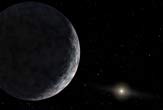
The dwarf planet Eris — once thought to be the largest body in the solar system beyond Neptune's orbit — may actually be smaller than Pluto, new observations suggest.
Three teams of astronomers watched through telescopes as the icy Eris passed in front of a distant star over the weekend. The length of the occultation — as the event is called — showed that Eris is likely less than 1,454 miles (2,340 kilometers) wide, the magazine Sky & Telescope reported.
This would make Eris a smidge smaller than Pluto, which is about 1,455 miles (2,342 km) wide.
Astronomers still believe Eris to be about 25 percent more massive than Pluto. But the size revision would allow Pluto to regain its status as the largest body in the Kuiper Belt, the icy ring of objects circling the sun beyond Neptune.
The new observation efforts, which involved dozens of astronomers around the world, were coordinated by Bruno Sicardy of the Paris Observatory.
The new look at Eris' size could provide Pluto a small measure of revenge, for Pluto was demoted from ninth planet to dwarf planet in 2006 partly due to the discovery of Eris (and later Eris' moon Dysnomia).
Dueling dwarf planets
Sign up for the Live Science daily newsletter now
Get the world’s most fascinating discoveries delivered straight to your inbox.
Eris was discovered in 2005 by planet-hunting astronomer Michael Brown of Caltech. The icy world has one known moon and a highly elliptical orbit, zooming about 9 billion miles (14.6 billion km) from the sun at its farthest point — making it about twice as distant as Pluto.
Early measurements of its size by Brown and others at the time suggested that Eris was slightly larger than Pluto.
Observations by both the Hubble and Spitzer space telescopes, for example, pegged Eris' width as roughly 1,491 miles (2,400 km). A research team using a Spanish radio telescope calculated Eris to be even bigger, around 1,864 miles (3,000 km) across.
The discovery of a "10th planet" larger than Pluto — and the prospect of finding an 11th planet, and a 12th and so on — ultimately led astronomers to reconsider Pluto's status as a full-fledged planet.
In 2006, the International Astronomical Union officially designated Eris and Pluto "dwarf planets," based on the fact that they hadn't cleared their orbital zones of other rocky objects. [Gallery: The New Solar System.]
The decision introduced a new category of solar system body, and it officially reduced the number of planets to eight. It also set off a controversy that still simmers today; some astronomers agree with the move, while others regard Pluto as a full-fledged planet.
Resizing (and rethinking) Eris
The new observations could help take a bit of the sting out of Pluto's demotion.
In an international effort led by Sicardy, dozens of astronomers around the world aimed their telescopes at Eris on Saturday (Nov. 6). Because the dwarf planet is so small and so far away, witnessing the occultation was no sure thing. It would only be visible from certain spots on Earth's surface.
But three teams of astronomers, using different telescopes set up throughout the Chilean Andes, had success. They watched Eris pass in front of a faraway star in the constellation Cetus and timed how long Eris blocked the star's light.
Such information, if recorded at multiple 050729_new_planet_00sites, can reveal with great precision how wide a spherical object is. (Astronomers think both Eris and Pluto are spherical). The size calculations made over the weekend may be more reliable than the earlier figures, according to Brown.
"Most of the ways we have of measuring the sizes of objects in the outer solar system are fraught with difficulties," Brown wrote on his blog Sunday (Nov. 7). "But, precisely timed occultations like these have the potential to provide incredibly precise answers."
If the new measurements are accurate, they make a strong case that Eris and Pluto are very different, Brown added.
While the two dwarf planets appear to have very similar surfaces, their interiors are likely quite different. Since Eris is much more massive, it's expected to be much denser — and much rockier — than Pluto.
"How could Eris and Pluto look so similar in size and exterior composition yet be totally unalike on the inside?" Brown wrote. "As of today I have absolutely no idea."
The new results suggest that Eris is similar to two other large Kuiper Belt objects, Haumea and Quaoar, according to Brown. All three bodies are likely mostly rock, with a thin coating of ice on the surface — not what astronomers had expected from objects in the outer solar system.
"In the past we've been willing to make up special explanations for [Haumea and Quaoar]. But Eris, too? Having to continue making up special explanations is becoming unpalatable," Brown wrote. "Something is going on in the outer solar system, and I don't know what."
This article was provided by SPACE.com, a sister site of Live Science.











